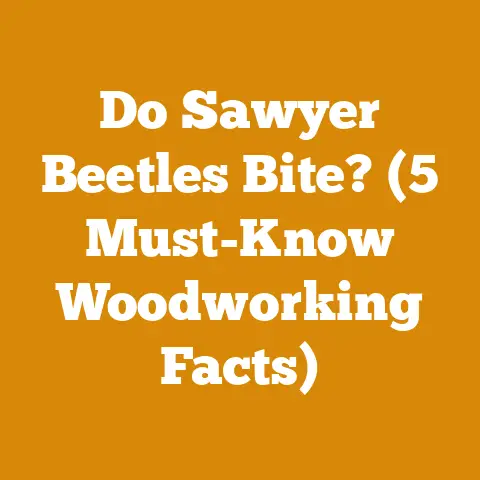How to Get Rid of Pine Beetles (5 Pro Tips for Tree Recovery)
Let’s talk about future-proofing your forest. It’s not just about today’s harvest; it’s about ensuring the health and longevity of your trees for generations. And right now, one of the biggest threats to pine forests across the globe is the pine beetle. These tiny insects can wreak havoc on entire ecosystems, leaving behind dead or dying trees and a landscape vulnerable to further problems. I’ve seen firsthand the devastation they can cause, and I know how disheartening it can be to watch your trees succumb to these pests. But don’t despair! There are steps you can take to protect your forest and help your trees recover.
How to Get Rid of Pine Beetles (5 Pro Tips for Tree Recovery)
The user intent is to find practical, actionable advice on how to manage and eliminate pine beetle infestations and promote tree recovery. The focus is on proactive measures, treatment options, and strategies to improve tree health and resilience.
Understanding the Pine Beetle Threat
Before I dive into the solutions, let’s get a handle on what we’re up against. Pine beetles, specifically mountain pine beetles (Dendroctonus ponderosae) and southern pine beetles (Dendroctonus frontalis), are native insects that play a natural role in forest ecosystems. However, when populations explode, they can overwhelm a tree’s defenses and kill it.
The beetles attack by boring into the bark, disrupting the tree’s ability to transport water and nutrients. They also introduce blue stain fungus, which further inhibits the tree’s vascular system. Signs of infestation include pitch tubes (small masses of resin on the bark), boring dust, and a change in needle color from green to yellow to red.
Several factors contribute to pine beetle outbreaks, including:
- Climate Change: Warmer temperatures allow beetles to reproduce more quickly and expand their range.
- Drought: Stressed trees are more susceptible to beetle attacks.
- Dense Forests: Overcrowded stands of trees provide ample food and breeding grounds for beetles.
- Lack of Forest Management: Neglecting thinning and other forest management practices can create conditions favorable to beetle infestations.
I remember one particularly bad year when a neighboring forest owner lost nearly half of his mature pines to a beetle outbreak. He hadn’t thinned his stand in decades, and the trees were stressed from a prolonged drought. It was a stark reminder of the importance of proactive forest management.
Pro Tip #1: Assess and Identify
The first step in combating pine beetles is to accurately assess the situation. Don’t just assume your trees are infested; confirm it.
- Inspect Your Trees Regularly: Walk through your forest and look for signs of beetle activity. Pay close attention to the lower trunk and branches.
- Look for Pitch Tubes: These are small, popcorn-sized masses of resin that form where beetles have bored into the bark. Fresh pitch tubes are often white or yellowish, while older ones may be brown or gray.
- Check for Boring Dust: This fine, sawdust-like material accumulates in bark crevices and around the base of the tree.
- Examine Needle Color: As beetles attack, the needles will start to change color. Initially, they may turn yellow or light green, eventually becoming reddish-brown.
- Peel Back Bark (Carefully): If you suspect an infestation, carefully peel back a small section of bark to look for beetle galleries (tunnels) and larvae.
- Consult with a Professional: If you’re unsure about your diagnosis, contact a certified arborist or forester. They can help you identify the type of beetle and recommend the best course of action.
I once spent an entire afternoon inspecting a stand of pines, only to discover that the discoloration was due to a fungal infection, not beetles. A proper diagnosis is crucial for effective treatment.
Pro Tip #2: Sanitation Logging and Removal
One of the most effective ways to control pine beetle infestations is through sanitation logging and removal. This involves removing infested trees to prevent the beetles from spreading to healthy trees.
- Target Infested Trees: Focus on removing trees that show clear signs of beetle activity. These are the ones that are actively harboring beetles and pose the greatest risk to surrounding trees.
- Remove Trees Promptly: The sooner you remove infested trees, the better. Beetles can emerge from trees in as little as a few weeks, depending on the temperature and beetle species.
- Proper Disposal: Once you’ve removed the trees, it’s crucial to dispose of them properly. This can be done in several ways:
- Burning: Burning the trees is an effective way to kill the beetles and prevent them from spreading. However, be sure to check local regulations and obtain any necessary permits before burning.
- Chipping: Chipping the trees into small pieces will also kill the beetles. The chips can then be used as mulch or compost.
- Debarking: Removing the bark from the trees will expose the beetles to the elements and kill them. The debarked wood can then be used for lumber or firewood.
- Burying: Burying the trees deep underground can also kill the beetles, but this method is not always practical.
- Timing is Key: The best time to conduct sanitation logging is during the dormant season (late fall and winter) when the beetles are less active.
- Safety First: Always wear appropriate safety gear when felling trees, including a hard hat, eye protection, hearing protection, and gloves. Use proper chainsaw techniques and be aware of your surroundings.
I’ve seen instances where landowners simply felled infested trees and left them on the ground, thinking they had solved the problem. Unfortunately, the beetles continued to emerge from the downed trees and spread to nearby healthy trees. Proper disposal is essential.
Here’s a list of tools I recommend for sanitation logging and removal:
- Chainsaw: A reliable chainsaw is essential for felling trees. I prefer a professional-grade saw with a bar length appropriate for the size of the trees you’re felling. (I use a Stihl MS 462 C-M with a 25-inch bar)
- Felling Axe or Wedge: These tools can help you direct the fall of the tree.
- Skidding Winch: A skidding winch can be used to drag felled trees out of the woods.
- Log Splitter: A log splitter can be used to split large logs into smaller pieces for easier disposal.
- Chipper/Shredder: A chipper/shredder can be used to chip the trees into small pieces.
- Personal Protective Equipment (PPE): Always wear appropriate PPE, including a hard hat, eye protection, hearing protection, gloves, and chainsaw chaps.
Pro Tip #3: Promote Tree Health and Vigor
Healthy trees are better able to resist beetle attacks. By promoting tree health and vigor, you can make your forest less susceptible to infestations.
- Thinning: Thinning overcrowded stands of trees reduces competition for resources and allows the remaining trees to grow stronger. Aim for a spacing that allows sunlight to reach the lower branches of the trees.
- Watering: During periods of drought, water your trees regularly, especially young trees.
- Fertilizing: Fertilize your trees in the spring to provide them with the nutrients they need to grow. Use a fertilizer specifically formulated for pine trees.
- Soil Testing: Conduct a soil test to determine if your soil is deficient in any essential nutrients.
- Mulching: Apply a layer of mulch around the base of your trees to help retain moisture and suppress weeds.
- Pruning: Prune dead or diseased branches to improve air circulation and reduce the risk of fungal infections.
- Control Competing Vegetation: Remove weeds and other vegetation that compete with your trees for resources.
I once helped a landowner revitalize a struggling pine stand by thinning it and applying a balanced fertilizer. Within a few years, the trees were noticeably healthier and more resistant to beetle attacks.
Pro Tip #4: Insecticide Applications
Insecticides can be used to protect individual trees from beetle attacks. However, they should be used as a last resort and applied carefully to minimize environmental impact.
- Preventive Treatments: Insecticides are most effective when applied as a preventive treatment before the beetles attack.
- Targeted Applications: Focus on treating high-value trees or trees that are at high risk of infestation.
- Proper Application: Follow the manufacturer’s instructions carefully when applying insecticides. Use the correct dosage and apply the insecticide evenly to the trunk of the tree.
- Licensed Applicator: Consider hiring a licensed applicator to apply insecticides. They have the knowledge and equipment to apply the insecticide safely and effectively.
- Types of Insecticides: Several insecticides are registered for use against pine beetles, including:
- Permethrin: A synthetic pyrethroid insecticide that is effective against a wide range of insects.
- Bifenthrin: Another synthetic pyrethroid insecticide that is similar to permethrin.
- Carbaryl: A carbamate insecticide that is also effective against pine beetles.
- Environmental Considerations: Be aware of the potential environmental impacts of insecticides. Avoid spraying near water sources or areas where beneficial insects are present.
I’ve used insecticides to protect individual trees in high-risk areas, such as near homes or other structures. However, I always emphasize that insecticides are not a long-term solution and should be used in conjunction with other management practices.
Here’s a list of equipment I recommend for applying insecticides:
- Backpack Sprayer: A backpack sprayer is ideal for applying insecticides to individual trees.
- Power Sprayer: A power sprayer can be used to apply insecticides to larger areas.
- Protective Clothing: Always wear protective clothing when applying insecticides, including a long-sleeved shirt, pants, gloves, and a respirator.
Pro Tip #5: Biological Control
Biological control involves using natural enemies of pine beetles to control their populations. This can include predators, parasites, and pathogens.
- Predatory Beetles: Several species of predatory beetles feed on pine beetles, including checkered beetles and clerid beetles.
- Parasitic Wasps: Parasitic wasps lay their eggs inside pine beetle larvae, killing them.
- Fungal Pathogens: Certain fungal pathogens can infect and kill pine beetles.
- Promoting Natural Enemies: You can promote natural enemies by providing them with habitat and avoiding the use of broad-spectrum insecticides.
- Augmentation: In some cases, it may be possible to augment natural enemy populations by releasing them into the forest.
- Research and Development: Research is ongoing to develop new biological control agents for pine beetles.
I’ve seen the effectiveness of biological control firsthand in areas where predatory beetles are abundant. They can help keep beetle populations in check and prevent outbreaks.
Case Studies and Research Findings
Several studies have demonstrated the effectiveness of different pine beetle management strategies.
- Thinning: A study in the Black Hills of South Dakota found that thinning reduced the incidence of beetle attacks by 50%.
- Sanitation Logging: A study in British Columbia found that sanitation logging was effective in controlling beetle outbreaks when implemented promptly.
- Insecticides: A study in the southern United States found that insecticide applications reduced tree mortality by 80%.
- Biological Control: A study in Colorado found that predatory beetles helped to suppress beetle populations in areas where they were abundant.
These studies highlight the importance of using a combination of management strategies to effectively control pine beetle infestations.
Common Mistakes to Avoid
- Ignoring the Problem: Ignoring a pine beetle infestation will only make it worse. The beetles will continue to spread and kill more trees.
- Delaying Treatment: Delaying treatment can reduce the effectiveness of management strategies. The sooner you take action, the better.
- Improper Disposal: Improper disposal of infested trees can allow the beetles to spread to healthy trees.
- Over-reliance on Insecticides: Insecticides should be used as a last resort and not as the sole management strategy.
- Neglecting Forest Management: Neglecting forest management practices can create conditions that are favorable to beetle infestations.
- Lack of Monitoring: Failing to monitor your forest for signs of beetle activity can allow infestations to go unnoticed.
I’ve seen landowners make these mistakes time and time again, and it always leads to worse outcomes. Proactive management and vigilance are key to protecting your forest.
The Importance of Long-Term Forest Management
Combating pine beetles is not a one-time fix; it’s an ongoing process that requires long-term forest management.
- Develop a Forest Management Plan: A forest management plan will help you set goals for your forest and develop strategies to achieve those goals.
- Regular Monitoring: Monitor your forest regularly for signs of beetle activity and other problems.
- Adaptive Management: Be prepared to adapt your management strategies as needed based on changing conditions.
- Collaboration: Collaborate with other landowners and forest professionals to share knowledge and resources.
- Education: Educate yourself about pine beetles and other forest pests.
I believe that long-term forest management is the key to ensuring the health and resilience of our forests for future generations.
Specific Details About Tools
Let’s dive into some specific tool recommendations, since I know how important it is to have the right equipment.
For felling larger trees, I recommend a professional-grade saw with a bar length of at least 20 inches. For smaller trees and limbing, a smaller, lighter saw will be more manageable. Consider the Stihl MS 261 C-M or the Husqvarna 562 XP.
Wood Drying Processes
Properly drying firewood is crucial for efficient burning and reducing creosote buildup in your chimney.
- Air Drying: The most common method of drying firewood is air drying. This involves stacking the wood in a well-ventilated area and allowing it to dry naturally. The drying time will vary depending on the species of wood, the climate, and the stacking method. Generally, it takes 6-12 months for firewood to dry properly.
- Kiln Drying: Kiln drying is a faster method of drying firewood. This involves placing the wood in a kiln and heating it to a specific temperature. Kiln drying can reduce the drying time to a few weeks.
- Solar Drying: Solar drying is a more environmentally friendly method of drying firewood. This involves building a solar kiln and using the sun’s energy to heat the wood.
- Moisture Content Targets: The ideal moisture content for firewood is 15-20%. You can use a wood moisture meter to check the moisture content of the wood.
Safety Procedures
Safety should always be your top priority when working with logging tools and preparing firewood.
- Personal Protective Equipment (PPE): Always wear appropriate PPE, including a hard hat, eye protection, hearing protection, gloves, and chainsaw chaps.
- Chainsaw Safety: Follow all chainsaw safety guidelines, including starting the saw on the ground, using proper cutting techniques, and being aware of your surroundings.
- Log Splitting Safety: Wear eye protection and gloves when operating a log splitter. Keep your hands clear of the splitting wedge.
- Firewood Stacking Safety: Stack firewood in a stable manner to prevent it from falling over.
- First Aid: Keep a well-stocked first aid kit on hand and know how to use it.
I always tell people, “There’s no rush in the woods.” Take your time, be careful, and prioritize safety above all else.
Actionable Metrics
Here are some actionable metrics you can use to measure your success in combating pine beetles and preparing firewood:
- Percentage of Trees Infested: Track the percentage of trees in your forest that are infested with pine beetles. This will help you assess the effectiveness of your management strategies.
- Tree Mortality Rate: Monitor the tree mortality rate in your forest. This will help you identify areas that are experiencing high levels of beetle activity.
- Firewood Drying Time: Track the time it takes for your firewood to dry to the desired moisture content.
- Firewood Moisture Content: Regularly check the moisture content of your firewood to ensure that it is properly seasoned.
- Processing Time: Track the time it takes you to process a cord of firewood. This will help you identify areas where you can improve your efficiency.
- Equipment Maintenance Schedule: Develop and follow a regular equipment maintenance schedule to ensure that your logging tools and firewood preparation equipment are in good working order.
Challenges and Contexts Faced by Small-Scale Loggers and Firewood Producers Globally
I understand that not everyone has access to the same resources and technology. Small-scale loggers and firewood producers around the world face unique challenges, including:
- Limited Access to Capital: Many small-scale loggers and firewood producers lack access to the capital needed to invest in modern equipment and technology.
- Lack of Training: Many small-scale loggers and firewood producers lack access to proper training in safe and efficient logging and firewood preparation techniques.
- Environmental Regulations: Small-scale loggers and firewood producers may face challenges complying with environmental regulations.
- Market Access: Small-scale loggers and firewood producers may have difficulty accessing markets for their products.
- Climate Change: Climate change is exacerbating the challenges faced by small-scale loggers and firewood producers, including increased drought, wildfires, and pest outbreaks.
I believe that it is important to support small-scale loggers and firewood producers by providing them with access to capital, training, and markets. We also need to work together to address the challenges posed by climate change.
Conclusion: A Call to Action
Pine beetle infestations are a serious threat to our forests, but they are not insurmountable. By understanding the threat, implementing proactive management strategies, and working together, we can protect our forests and ensure their health and resilience for future generations.
I urge you to take action today to protect your trees. Assess your forest, remove infested trees, promote tree health, and consider using insecticides or biological control agents if necessary. And remember, long-term forest management is the key to success.
Let’s work together to keep our forests healthy and vibrant. Your efforts will make a difference.






